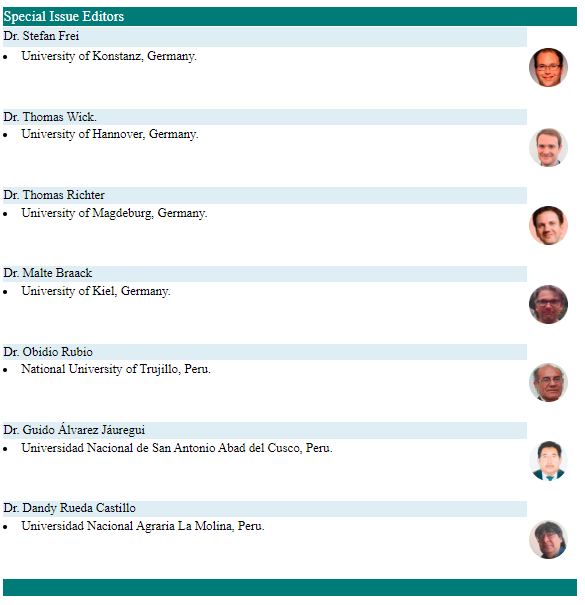SIMULACIÓN METEOROLÓGICA A NIVEL MESOESCALA DEL NORTE DE PERÚ (2015) USANDO BRAZILIAN REGIONAL ATMOSPHERIC MODELLING SYSTEM (BRAMS)
DOI:
https://doi.org/10.17268/sel.mat.2015.02.01Palabras clave:
Simulación numérica, BRAMS, clima, fenómeno El Niño, modelamiento atmosféricoResumen
El calentamiento de las aguas del pacífico generan la llegada del fenómeno del El Niño; el Perú en los años 1997 y 1998 sufrió grandes pérdidas tanto material como víctimas humanas, en la actualidad con distintas técnicas se predice la magnitud de los fenómenos naturales. Nuestro objetivo es estudiar los cambios en las variables meteorológicas como son; Temperatura, Campos de viento y Humedad relativa, en los meses de octubre a noviembre del 2015 y comparar con los años 1997 y 1998. Se utilizó el modelo BRAMS (Brazilian Regional Atmospheric Modelling System ) el cualpermite analizar diferentes variables metereológicas en distintos periodos de tiempo; la variación de la temperatura en el norte del Perú oscila entre 18 a 29 grados centígrados, la humedad relativa
entre 35 a 100% para la costa, los campos de viento de 2.7 km/h a 9.9 km/h, las ciudades como Tumbes, Piura, Lambayeque y La Libertad presentan una disminución de 9, 5, 6 y 6 grados
centígrados en el mes de octubre a Noviembre, respectivamente. Por tanto, podemos concluir que las variables metereoógicas han disminuido para el mes de noviembre en el 2015 lo cual no ha
ocurrido en los años del fenómeno del niño 1997 y 1998 cuyos valores se mantuvieron constantes.
Citas
Chang, Y-T. and Du, L. and Zhang, S-W. and Huang, P-F, Sea level variations in the tropical Pacific Ocean during two types of recent El Niño events, Global and Planetary change, V108, 119-127,2013.
Chen, D. and Cane, M.A, El Niño prediction and
predictability, Computational physic, volume =227, (2008), 3625-3640.
Dewitte, B. and Vazquez-Cuervo, J. and Goubanova, K. and Illig, S. and Takahashi, K. and Cambon, G. and Purca, S. and Correa, D. and Gutierrez, D. and Sifeddine, A. and Ortlieb, L., Change in El Niño flavours over 1958-2008: Implications for the long-term trend of the upwelling off Peru, Deep-Sea Research II, 77, (2012), 143-156.
Garcia, A. M. and Vieira, J. P. and Winemiller, K. O., Effects of 1997-1998 El Niño on the dyamics of the shallow-water fish assenblage of the Patos Lagoon Estuary (Brazil), Estuarine, Coastal and Shelf Science, 57, 489-500, (2003).
Colas, F. and Capet, X. and McWilliams J. C. and Shchepetkin, A., 1997-1998 El Niño off Peru: A
numerical Study, Progress in Oceanography, 79, (2008), 138-155.
Guinez, M. and Valdés, J. and Sifeddine, A. and Boussafir, M. and Dávila, P. M., Anchovy population and ocean-climatic fluctuations in the Humboldt Current System during the last 700 years and their implications, Palaeogeography, Palaeoclimatology, Palaeoecology, 415, (2014), 210-224.
Avissar, R. and Pielke, R. A., The impact of plant stomatal control on mesoscale atmospheric circulations, Agricultural and Forest Metereology, 54, (1991), 353-372.
Davey, Ch. A. and Pielke, R. A. and Gallo, K. P., Differences between near-surface equivalent temperature and temperature trends for the Eastern United States Equivalent temperature as an alternative measure of heat content, Global and Planetary Change, 54, (2006), 19-32.
, Garcia, S. Y. and Salio, P. and Nicolini, M., Verificación de los pronosticos del modelo BRAMS centrado en la región subtropical de sudamerica, Rev. Brasile~na de Metereologia, 27(3), (2012), 291-306.
Oliveira de Souza, D. and dos Santos A. R. and Guedes, M. N, Urbanization effects on the microclimate of Manaus: A modeling study, Atmospheric Research, 167, (2016), 237-248
Descargas
Publicado
Cómo citar
Número
Sección
Licencia
Los autores/as que publiquen en esta revista aceptan las siguientes condiciones:
- Los autores/as conservan los derechos de autor y ceden a la revista el derecho de la primera publicación, con el trabajo registrado con la licencia de atribución de Creative CommonsAtribución 4.0 Internacional (CC BY 4.0) , que permite a terceros utilizar lo publicado siempre que mencionen la autoría del trabajo y a la primera publicación en esta revista.
- Los autores/as pueden realizar otros acuerdos contractuales independientes y adicionales para la distribución no exclusiva de la versión del artículo publicado en esta revista (p. ej., incluirlo en un repositorio institucional o publicarlo en un libro) siempre que indiquen claramente que el trabajo se publicó por primera vez en esta revista.
- Se permite y recomienda a los autores/as a publicar su trabajo en Internet (por ejemplo en páginas institucionales o personales) antes y durante el proceso de revisión y publicación, ya que puede conducir a intercambios productivos y a una mayor y más rápida difusión del trabajo publicado(Consultar: efecto del acceso abierto).













